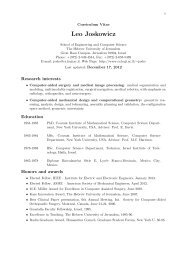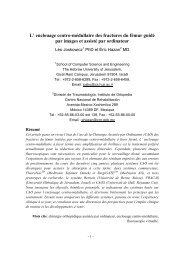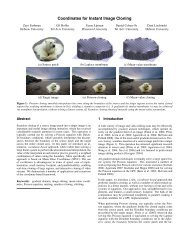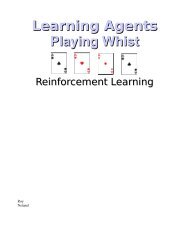TEL AVIV UNIVERSITY Gaddi Blumrosen
TEL AVIV UNIVERSITY Gaddi Blumrosen
TEL AVIV UNIVERSITY Gaddi Blumrosen
You also want an ePaper? Increase the reach of your titles
YUMPU automatically turns print PDFs into web optimized ePapers that Google loves.
:<br />
Table 2: The benefits of smart antennas techniques ([12])<br />
Feature Benefit<br />
Signal gain—Inputs from multiple<br />
antennas are combined to optimize<br />
available power required to<br />
establish given level of coverage.<br />
Interference rejection—Antenna<br />
pattern can be generated toward<br />
cochannel interference sources,<br />
improving the signal-to-interference<br />
ratio of the received signals.<br />
Spatial diversity—Composite<br />
information from the array is used<br />
to minimize fading and other<br />
undesirable effects of multi-path<br />
propagation.<br />
power efficiency—combines the<br />
inputs to multiple elements to<br />
optimize available processing gain<br />
in the downlink (toward the user)<br />
3.2 Beamforming<br />
3.2.1 Introduction<br />
Better range/coverage—Focusing the energy sent out<br />
into the cell increases base station range and coverage.<br />
Lower power requirements also enable a greater battery<br />
life and smaller/lighter handset size.<br />
Increased capacity—Precise control of signal nulls quality<br />
and mitigation of interference combine to frequency reuse<br />
reduce distance (or cluster size), improving capacity.<br />
Certain adaptive technologies (such as space division<br />
multiple access) support the reuse of frequencies within the<br />
same cell.<br />
Multi-path rejection—can reduce the effective delay<br />
spread of the channel, allowing higher bit rates to be<br />
supported without the use of an equalizer<br />
reduced expense—Lower amplifier costs, power<br />
consumption, and higher reliability will result.<br />
Beamforming (BF) utilizes transmitted and/or received signals phase and amplitude<br />
induced in each antenna in an antenna array, to form beams in different desired<br />
directions. BF can be seen as moving from antenna space to beam space by Fourier<br />
transform.<br />
There are two main ways for BF. The first one is with fixed beam patterns - the beams<br />
are fixed and predetermined and the transmitter can switch from one to another and is<br />
called Switched-Beam BF. The other way, non-fixed beam patterns, is obtained by<br />
continuous updating of antenna weights according to CSI knowledge and subscriber<br />
spatial distribution. By this way optimal BF can be achieved. When the beamforming<br />
weights are changed adaptively, it is called adaptive BF.<br />
We will start in 3.2.2 with a description of SVD based BF. On 3.2.3, we introduce<br />
MMSE based BF. BF methods performance is briefly discussed in 3.2.4. In 3.2.5, a<br />
physical perspective of BF is shown.








